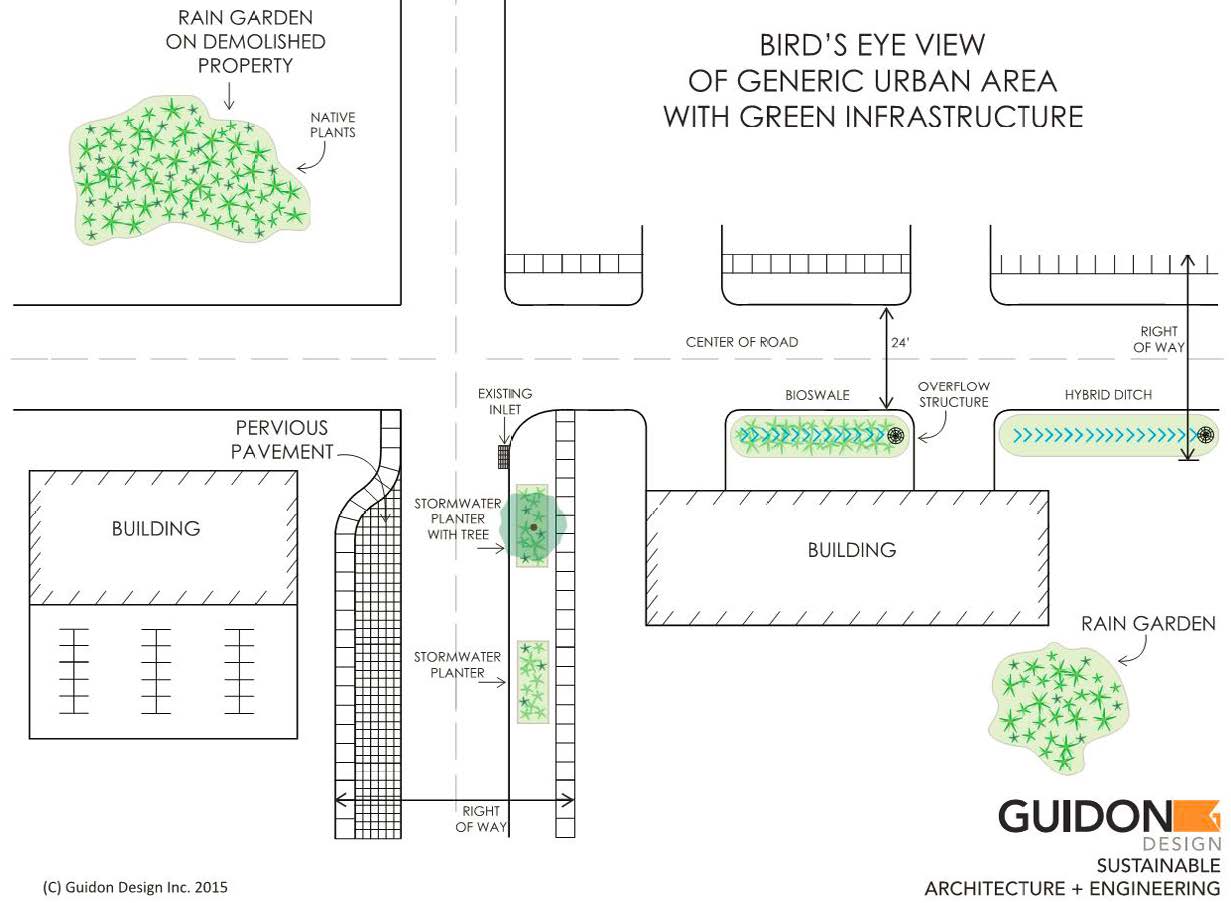Delta Institute has an array of GI resources that are free, open-source, and available for partners to utilize to address flooding, stormwater runoff, and an array of water quality issues in Great Lakes / Midwestern communities.
Delta Institute (Delta) is proud and pleased to be a long-term proponent and planner of Green Infrastructure (GI). Indeed, Delta assists communities by integrating natural climate solutions and Green Infrastructure (GI) to reduce climate change impacts by capturing 100 million stormwater gallons and leveraging $100 million in municipal GI investment. We focus on communities who are disproportionately affected by flooding and climate change, to collaboratively improve their environment, mitigate local impacts of climate change, and strengthen their neighborhoods’ resilience to increasingly damaging weather events.
Why is GI and Stormwater Management so Crucial for Municipalities?
The impacts of climate change are accelerating. Cities and regions throughout the Midwest continue experiencing increased flooding, water pollution from stormwater runoff, and degrading infrastructure—all threatening public health, water quality, economic opportunity, and quality of life. Stormwater runoff comes from rain, snow, or sleet that carries over land or impervious surfaces. This runoff can either soak into soil, flow into rivers or basins, or evaporate into the air. In nature, trees, plants, and the ground naturally absorb most of this water, ensuring healthy stream flows and clean water.
However, in urban areas with more solid surfaces like roads and buildings, the water cannot soak into the built environment. As such, the stormwater runoff can consequently lead water to collect pollutants like oil, litter, fertilizer, chemicals, and other harmful substances, causing pollution, flooding, and erosion in areas where it’s not properly managed.
A more comprehensive solution to flooding is needed that aligns traditional infrastructure with innovative practices. For Midwestern communities to viably address their rising stormwater and flooding concerns, an integrated approach is needed to safeguard homes and improve water quality.
Innovative, nature-based solutions are needed, and helpful for communities to use.
Green Infrastructure (GI) is a management technique that takes advantage of natural processes that allow water to infiltrate soil while minimizing discharge into nearby waterways. Effective management of stormwater and flooding is a priority of many municipalities. However, municipalities often face barriers to green infrastructure implementation, such as the lack of capacity and technical expertise, and constrained human and financial resources.
Integrating communities’ current infrastructure with natural and green infrastructure—including solutions like rain gardens, stormwater planters, permeable pavements, and bioswales—will help the Midwest address the emerging stormwater management crisis in a more cost-effective manner, while also increasing access to green space. More communities are acting through implementing and scaling GI.
However, many communities face barriers which prevent adoption: planning, design, multi-agency coordination, connecting natural systems with gray infrastructure, funding, procurement financing, maintenance, and monitoring.
In addition to their environmental and climate benefits, GI and nature-based designs also have positive effects on communities’ insurance rates, median income, housing prices, and other economic indicators. Our work also streamlines the process for municipalities to gain access to emerging carbon and water trading markets.

Bird’s eye view of generic urban area with green infrastructure. Credit: Guidon Design

Bioswale design. Credit: Guidon Design and Delta Institute
Available Resources for Communities that are Free and Open-Source for Use, Today
A Designs Guide for Green Stormwater Infrastructure Best Management Practices
Delta Institute’s GI Designs Toolkit builds from our many years of GI experience, and aims to help municipal managers and decision-makers begin the process of implementing GI in their community. Featuring a decision support tool and downloadable design templates for bioswales, rain gardens, stormwater planters, permeable pavement, and underground storage, the publication offers practical tools that can be scaled to sites across a wide geography.
Written for municipal managers and decision-makers, this toolkit aims to provide users with a clearer understanding of how to identify opportunities for green infrastructure implementation, which GI treatments are most suitable for a specific site or purpose, and how to make informed decisions based on reasonable cost estimates.
Developed in partnership with Guidon Design, Environmental Consulting & Technology, Inc., and with input from members of the Calumet Stormwater Collaborative, we’re thrilled to provide these materials that includes decision support tools, design templates for five GI treatments; with accompanying technical drawings, construction notes, and cost and maintenance information. We routinely update the GI Designs Template, with versions from 2015 and 2017. The most recent version is available for download below; please watch for future updates.
You’re welcome to download the full GI Designs Toolkit, or select just the open-source CAD files. Municipalities have provided their engineers and/or landscape designers with these CAD files to streamline the design and installation process–thus reducing costs and time.
Bioswale / Hybrid Ditch
Bioswale / Hybrid Ditch CAD Files only
Stormwater Planter
Stormwater Planter CAD files only
Permeable Pavement
Permeable Pavement CAD Files only
Underground Storage
Underground Storage CAD Files only
Rain Garden
Rain Garden CAD Files only
The above listed GI Designs Guide, and all the CAD files, may also be found and downloaded from our Tools and Publications roster.


